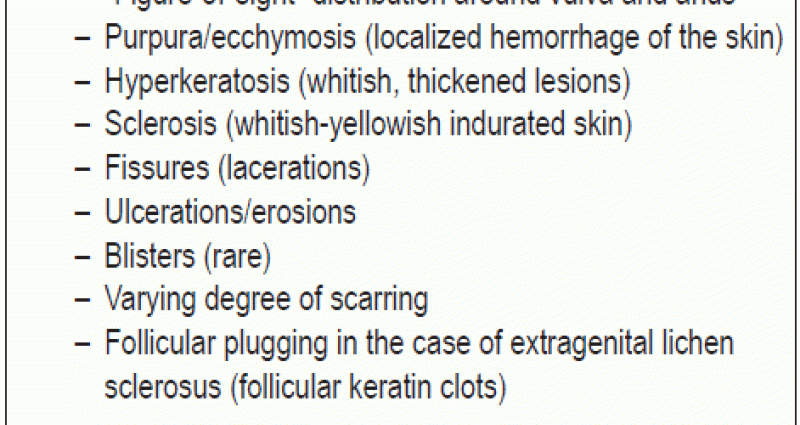Syn.: genital lichen planus.
Def .: A variety of LP localized on the mucous membranes of the genital organs.
Epid .: 20-25% of women and 3,7% of men with OLP have symptoms of the disease on the genitals. In about 15% of patients with mucosal lesions, typical lumps of LP on the skin are also present.
Etiol: Autoimmune, lichen planus.
Localization: The lesions are located on the vulva, vagina, glans and foreskin.
Clinical: There are characteristic, milky-white, reticular, tree-shaped or ring-shaped spots, erythematous changes or erosions on the genital organs. In addition, dark red or brown lumps similar to those elsewhere may be present. Typical glowing polygonal lumps are relatively rare. The most common lesions are erosions in the vulva and vagina, and less often in the glans. Erosive lesions are usually accompanied by characteristic tree-like white spots. When lesions are located in the vagina, symptoms of vaginitis are present, the epithelium is inflamed with numerous erosions, bleeding easily, and yellow discharge is present. There are characteristic white spots in this location. With the chronic course of the disease, adhesions and narrowing of the vagina may occur. The changes are accompanied by strong subjective symptoms: discomfort, burning, soreness during sexual intercourse. The simultaneous occurrence of erosive or exfoliative lesions on the gingiva, vulva and vagina has been described as “vulvovaginal-gingival syndrome”.
Hist .: Aquatic degeneration of the basal layer cells, presence of Civatt bodies in the lower epithelium, elongation of sawtooth-shaped epithelial papillae. Just below the epithelium there is a tightly fitting infiltrate consisting mainly of lymphocytes and histiocytes.
DI: In the zone of the basement membrane, linear-granular fibrin and fibrinogen deposits are found.
DR: Actinic keratosis, thrush, psoriasis, Bowen’s disease, lichen sclerosus and atrophic, pemphigus, pemphigus, exudative erythema multiforme.
But: Erosive lesions are quite resistant to treatment. Topical steroids and tacrolimus are used, and generally – prednisone at a dose of 20-40 mg / day for 2-4 weeks, hydroxychloroquine at a dose of 200 mg / day, oral retinoids: isotretinoin at a dose of 1 mg / kg or acitretin, sometimes cyclosporin and others immunosuppressants. Monitoring the cleanliness of the vagina, in the case of yeast or bacterial infection, the use of appropriate preparations.
Year: Moderate lesions quite resistant to treatment, they like to recur. With long-term changes, there is a risk of developing squamous cell carcinoma.
DIG. L-24. Lichen planus located on the vulva.
DIG. L-25. Lichen planus of the vulva.
Lit.: [1] Moyal-Barracco M., Edwards L.: Diagnosis and therapy of anogenital lichen planus. Dertatol Th er 2004, 17; 38-46. [2] Eisen D., Carrozzo M., Bagan Sebastian J.-V. i wsp.: Oral lichen planus: clinical features and management. Oral Diseases 2005, 11; 338-49. [3] Setterfi eld J.F., Neill S., Shirlaw P.J. i wsp.: Th e vulvovaginal gingival syndrome: a severe subgroup of lichen planus with characteristic clinical features and a novel association with the class II HLA DQB1*0201 allele. J Am Acad Dermatol 2006, 55; 98-113.
Source: A. Kaszuba, Z. Adamski: “Lexicon of dermatology”; XNUMXst edition, Czelej Publishing House










